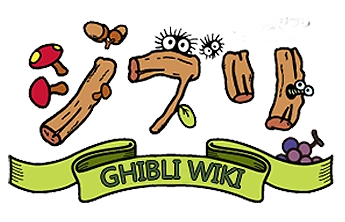Panda! Go, Panda! (パンダ・コパンダ , Panda Kopanda lit. Panda, Baby Panda) is an animated film that premiered on December 17, 1972. It was written and created by Hayao Miyazaki and directed by Isao Takahata for TMS Entertainment (formerly Tokyo Movie), predating Studio Ghibli. It was followed by a sequel, Panda! Go, Panda! Rainy Day Circus (1973).
This short movie hit Japan at the height of the panda craze, initiated in September 1972, when the government announced the loan of a pair of giant pandas from China to the Ueno Zoo as part of Panda diplomacy.Panda!_Go,_Panda!#cite_note-books.google.com.au-0 [1] Yōichi Kotabe (animation director) and Yasuo Ōtsuka (animation director, character design) contributed to the production.
A success in Japanese theaters, its creators followed up with Panda Kopanda and the Rainy-Day Circus in 1973, which was also a success. In 1974, Takahata, Miyazaki and Kotabe would create the landmark anime series Heidi, Girl of the Alps. In 1985, Takahata and Miyazaki would found Studio Ghibli.
Panda Kopanda is known in North America by the title, Panda! Go Panda! The two short films was first released in North America on DVD on January 6, 2004, by Geneon[1], while the Blu-ray edition was released by Discotek Media on June 27, 2017.[2]
Plot[]
Panda! Go, Panda![]
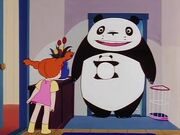
Mimiko greeting her new Papa Panda.
The plot follows Mimiko, a bright little girl left alone when her grandmother leaves on a trip, which, according to the grandmother, is Mimiko's grandfather's memorial service. After making a few stops at some local stores, Mimiko comes home to her house in a bamboo grove and finds a baby panda named Panny sleeping on the back doorstep. She quickly makes friends with the little panda, and invites him in for a drink. His father, Papa Panda, soon comes to visit, and they decide to become a family after Papa Panda offers to be Mimiko's father (Mimiko never had any parents). The three adjust to life together during their first night together, while Mimiko writes the first of many letters to her grandma (who she promised to write to every day).
The next day, Mimiko goes to school, reluctantly allowing Panny to tag along (even though she told him to stay home). In a close call, Panny ends up getting all of Mimiko's school (save for Mimiko) chasing after him. The next day, Mimiko gets an unexpected visit from a local policeman, who came to check on her. Expectedly, he freaks out after seeing Papa Panda. He goes to notify the local zoo staff, who invites the zookeeper (who lost Papa Panda and Panny after they broke out of the zoo). The zookeeper demands the safe return of his pandas, so he joins the police and zoo staff in the search.
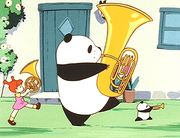
Mimiko, Papa Panda and Panny forming a little band.
Meanwhile, Mimiko and her family go out on a walk and, after scaring off some local bullies, they inadvertently lose Panny after he rolls down a hill. Mimiko and Papa Panda go searching for him, eventually gaining help from local police and the zookeeper in the search. They find Panny floating on a piece of wood, heading towards an open floodgate and hurry to save him. The handle, however, has rusted, leaving Panny in a dangerous situation. Mimiko comes very close to falling into dangerous waters after she jumps down to save Panny from death, but Papa Panda saves both of them by closing the floodgate. Mimiko, alongside Panny, Papa Panda, the zookeeper and the local police, cheer their success. Papa Panda, alongside Panny, return to work at the zoo, under the condition that they can leave after the visitors have left to spend time with Mimiko.
The Rainy-Day Circus[]
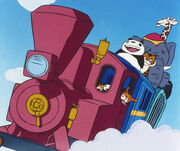
Wacky antics ensue with the Panda family and Tiny.
The Panda family's misadventures continue in the sequel, Panda! Go, Panda!: The Rainy-Day Circus (パンダ・コパンダ 雨降りサー スの巻 , Panda Kopanda: Amefuri Circus no Maki). In this episode, Mimiko and the pandas meet a ringmaster and one of his cronies, who were searching for something in their home. Mimiko is overjoyed, thinking that they are burglars, but they are quickly scared off by the family, and run away in fear. The family soon starts dinner, but Panny finds his food has been eaten. In a way similar to the story of Goldilocks, Panny finds what the ringmaster was looking for: a baby tiger named Tiny. After getting spooked by Tiny, Panny (along with the entire household) makes friends with the little tiger.
The next day, Mimiko goes to ask around town, to see if anyone knows where Tiny is from, only to lose both Panny and Tiny when Tiny goes to see his real mother. Mimiko is invited to the local circus, which is exactly the same one that is owned by the ringmaster that had tried to break in the night before, by a few of her friends. She gladly accepts the offer. At the circus, Tiny introduces Panny to balancing on a ball. Panny tries to do that trick, but ends up getting chased by the local circus performers and the ringmaster. To make matters worse, Panny crashes straight into the tiger cage, where Tiny's unhappy mother waits. Mimiko slips into the circus after someone yells that Panny is in trouble and runs into Tiny's mom. They both return what isn't theirs to the other (respectively, Panny to Mimiko and Tiny to his mother) and become quick friends. The ringmaster gives Mimiko and her family tickets to the show, but on the way home, a nasty storm breaks out. Overnight, it floods most of the land around Mimiko's hometown.
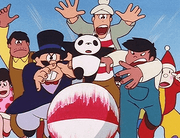
Panny getting into all sorts of trouble in the circus.
A frantic cry of help from Tiny (in the form of a makeshift bottled message) sends Mimiko and her family in a search for him. They learn from the ringmaster that the train has all the animals, and it's stuck out in the middle of nowhere. Mimiko and her family go to free the animals, which they succeed in doing, but unintentionally cause the train to start (due to the playful antics of Panny and Tiny).
The train goes off the rails, and ends up in a collision course with the mayor's house. However, Papa Panda stops the train, and Mimiko and her family become town heroes. The movie concludes with Mimiko and her panda family enjoying a day at the circus before marching in a line at the house while blowing horns (Panny plays a trumpet (which appeared to be broken earlier and somehow fixed), Mimiko plays a french horn, and Papa Panda plays a tuba).
Behind the Scenes[]
Development[]
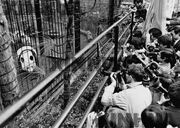
The Panda craze swept Japan in 1972.
In September 1972 (Showa 47), China offered a pair of giant pandas to Ueno Zoo as part Panda diplomacy. This caused a panda boom in Japan, and this animated film capitalized on the crazy. However, Director Isao Takahata has clarified that planning Panda Kopanda began long before.
It was one of the entries in the Toho Champion Festivals, and was simultaneously screenings with two other works, Destroy All Monsters (1968) and Kaijū funsen–Daigorō tai Goriasu (1972).
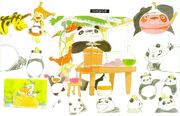
Image boards and concept sketches by Yōichi Kotabe.
The film was a collaboration between Isao Takahata, Hayao Miyazaki and Yōichi Kotabe, who had transferred from Toei Animation to A Production (later Shin-Ei Animation ).
Kotabe and Takahata had previously worked on Heidi, Girl of the Alps (1974) and were originally planning to adapt Astrid Lindgren's Pippi Longstocking, but couldn't due to failing to acquire the original author's permission. Panda Kopanda features elements taken from Pippi such as the protagonist Mimiko living alone, Mimiko's design (braids with freckles on her face), and the setting of Mimiko's house (kitchen with oven).
Production[]
"I didn't direct. I did key animation. It's a bit embarassing to have all these credits strung along after my name."
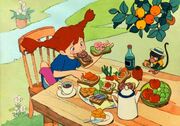
Isao Takahata, Hayao Miyazaki and Yōichi Kotabe worked on the failed Pippi Longstocking before Panda Kopanda.
At that time, A Production was an exclusive subcontractor for Tokyo Movie, but this project is said to have been planned and produced under A Production.
According to Miyazaki who developed the scenario, "(They) Told me to come with any kind of project starring a panda, Isao Takahata and I worked up this idea in one night or two. The decision to greenlight the production came a long time later, after a news announcement that a panda was arriving from China. Then the project was immediately given the go-ahead.
We talked about a simple idea and what kind of film we wanted to make and sent it out to a certain screenwriter. While waiting for the first version of the scenario, we created an image board in the style of a storyboard, with specifics fleshing out our idea.
Dissatisfied with the first version of our script, we decide it would take too long to wait for a second version; we received the company's approval o the condition that we would write the scenario. Takahata and I talked the story over, and I wrote it up based on the image board.
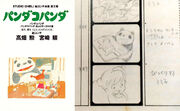
Studio Ghibli Storyboard Complete Works Series 2 #7 (スタジオジブリ絵コンテ全集第II期) compiles the animated short's storyboards.
The text wasn't in the form of a scenario, so I asked the person in charge of continuity to write it up clearly so it could be printed, and then started working on the storyboard with Takahata.
In the case of the film, we were in clear accord in our aim, thanks to the work we had previously done together. As I had written the scenario with the intention of making it a basis for our work, it was self-styled document with a far greater number of stage directions than usual. At the story board stage, the pictures I had drawn for the script were expertly arranged by Takahata. The features I subconsciously had in mind for the characters were transformed in the language of film. This was very satisfying to me. I have never had more pleasure as I worked.
For the sequel, we decided from the start that I would write the scanrio. Lounging around Takahata's house, he and i chatted what kind fof story it would be and discovered that we shared a childhood attraction to floods. I wrote up a scenario that was very much like production notes. As I recall, I again asked the continuity person to write it up clearly."[4]
On March 17, 1973, the sequel Panda Kopanda Rainy Day Circus was released.

A special Play and Learn Panda! Go, Panda! Talking Picture Book was released on November 23, 2012 to commemorate the short films' 40th anniversary. It cost 7,140 yen.[5]
On March 15, 2008, Panda Kopanda and Panda! Go, Panda! Rainy Day Circus were screened simultaneously in Cinema Angelica in Shibuya and several parts of Japan for six months. It was broadcast on TV by CS broadcasting stations and later rebroadcast on Cartoon Network.
The pandas of Panda! Go, Panda! are considered by some to be precursor of My Neighbor Totoro, sharing many design and animation similarities. The spunky red-headed heroine, Mimiko, is sometimes seen as a mix of a prototype Mei, the younger sister in My Neighbor Totoro (because of her braided hair) and a prototype Satsuki, the older sister in My Neighbor Totoro (due to her acting as an older sibling to Panny). Mimiko also shares several traits with Pippi Longstocking. Astrid Lindgren had been contacted by Miyazaki one year earlier, as he wished to use Pippi in his animation. His request was refused.
Creator's Message[]
Vision of Japan[]
On the Laserdisc box of Panda! Go Panda!, distributed by Pony Canyon on August 19, 1994, Hayao Miyazaki wrote an essay that elaborated on the hardships Japan had been facing when they released the film, and his intent as one of its creators:
"The landscape of the cherry tree-lined streets, the garden where the cosmos flowers bloom, and the quiet suburb where cars rarely pass are from the Kandagawa of my childhood, a town by the river that was later sung about as a polluted waterway. Naturally, the world realized in the film was not the reality of those days.All of Japan was far poorer than it is now; adults and children lived burdened with difficulties and hardships different from those we experience today. Or perhaps not that different. Since then, we Japanese have worked hard to escape poverty and have become incomparably wealthy in material terms. Many people now realize that as the same time we have lost so much.
The world depicted in Panda! Go Panda! is not a product of nostalgia for those of us who worked on it. The work is an effort to depict, at least in animated film, Japan as it might have become, the landscape showing streets that should have been, the scenery that even now has the potential to appear the way we depicted it. This vision of Japan remains a meaningful challenge facing us even now."
Meaningful Entertainment[]
In a retrospective essay on This is Animation: Panda! Go Panda! Rainy Day Circus published on September 1, 1994, Miyazaki wrote:
"Panda! Go Panda! is a film from some twenty years ago, but for us (Isao Takahata, Yasuo Ōtsuka, Yoichi Kotabe-san, and myself) This film remains very meaningful.At the time it was thought that children liked flashy, noisy films. But we thought that fun and excitement are best found in the small moments of everyday life. We made Panda! Go Panda! in the hope it would be something children would enjoy.
When the film was released, I went to the movie theater with my son and niece. It was shown with a Godzilla movie and it wasn't very long. But the children who came to watch it enjoyed it immensely. at the end they sang along with the theme song. I was thrilled. I recall feeling very happy at the sight of those children. And I think it was because of the support of those children that I decided o eh kind of work I'd do from then on.
By the way, Panda is a very big-hearted and easygoing character. He makes those around him happy just by being there, without doing anything in particular. In that respect Totoro and Panda are similar for me. I think films that children feel are thorougly fun cam make people of all ages happy."
Voice Cast[]
Original[]
- Bully - Osamu Ichikawa
- Stork Clerk - Tetsuya Kaji
- Papa Panda - Kazuo Kumakura
- Nana (Friend A) - Hiroko Maruyama
- Cayo (Friend B) - Yoneko Matsukane
- Teacher - Eken Mine
- Baby Panda - Yoshiko Ohta
- Grandmother - Reiko Seno
- Mimiko - Kazuo Sugiyama
- Zoo Director - Ayao Wada
- Omawari-san - Yasuo Yamada
- Mori (Male Student) - Yoko Yamaoka
CINAR Dub[]
- Julian Bailey - Additional Voices
- Eramelinda Boquer - Additional Voices
- Aimée Castle - Additional Voices
- Tedd Dillon - Additional Voices
- Dean Hagopian - Additional Voices
- Terry Haig - Additional Voices
- A.J. Henderson - Additional Voices
- Liza Hull - Additional Voices
- Walter Massey - Papa Panda, Additional Voices
- Kaia Scott - Additional Voices
- Jeremy Steinberg - Additional Voices
- Jane Woods - Additional Voices
Animaze Dub[]
- Bully, Diner Lady - Mona Marshall
- Stork Clerk - Doug Lee
- Papa Panda - Dougary Grant
- Nana (Friend A) - Katie Evans
- Cayo (Friend B) - Barbara Goodson
- Teacher - Sparly Thornton
- Panny - Melissa Fahn
- Grandmother - Aline Leslie
- Mimiko - Julie Maddalena
- Zoo Director - Simon Isaacson
- Policeman - Gully Jimson
- Mori (Male Student) - Ian Hawk
- Additional Voices
- Dougary Grant
- Alexis A. Edwards
- W.T. Hatch
- Dan Martin
- Harold Muckle
- Claude Wayne
- Heidi Wilbur
- G. Gordon Baer - Circus Boss
- Chet Huntley - Zoo Guard
- Steve Kramer - Man with Ladder
- Cody MacKenzie - Younger Boy
Credits[]
| Credit | Staff |
|---|---|
| Director | Isao Takahata |
| Screenplay | Hayao Miyazaki |
| Character Design | Yasuo Ōtsuka |
| Animation Director | Yasuo Ōtsuka, Yôichi Kotabe |
| Art Director | Hisao Fukuda, Shichirō Kobayashi |
| In-between Animation | Fumio Shinagawa, Hiroko Kikuchi, Hiroko Kodama, Hiroshi Fukutomi, Kanji Hara, Kazue Morimoto, Kazuko Tsurutani, Kazunori Tanahashi, Kazuo Minato, Kazuyoshi Shimada, Kenji Haruki, Kensetsu Fukuhara, Kiyoshi Naramura, Mariko Murata, Masako Chiba, Masashi Kubota, Megumi Ueno, Michiko Takahashi, Michiyo Yamada, Minoru Maeda, Roku Shinohara, Satoshi Oshima, Seiji Arihara, Shinichi Otake, Takao Horie, Takeshi Motoori, Tamayo Hirata, Tomoko Tanaka, Yoshitaka Gojo, Yukio Suzuki, Yuko Sakashita |
| Background | Akio Fujitsuka, Eiji Hirakawa, Etsuo Sato, Hiroko Igarashi, Hirotsugu Tani, Ichiro Nakano, Junko Kubota, Kazuo Oga, Kazutoshi Shimizu, Kenji Kumugai, Kimiko Kitagawa, Kumiko Yoshizawa, Masato Itou, Noboru Tatsuike, Toshiharu Mizutani, Toshiro Nozaki, Yasuyuki Chiba, Yumiko Honma |
| Key Animation | Eiichi Nakamura, Hayao Miyazaki, Hideo Kawauchi, Hiroshi Kanazawa, Hiroshi Wagatsuma, Kenji Kitahara, Kenzo Koizumi, Kōichi Murata, Motoji Suzuki, Norio Yazawa, Shingo Arakai, Syunji Saita, Takao Kōzai, Tomekichi Takeuchi, Toshiyuki Honda, Tsutomu Tanaka, Yasuhiro Yamaguchi, Yasuo Otsuka, Yôichi Kotabe, Yoshifumi Kondō, Yuzo Aoki |
| Editing | Kazuo Inoue |
| Photography | Akio Wakana, Katsuji Misawa, Mikio Wakana, Toru Owada |
| Concept | Hayao Miyazaki |
| Music | Masahiko Satoh |
Trivia[]
- Arsene Lupin III and Daisuke Jigen have cameos in the cheering crowd at the end.
References[]
- ↑ Panda! Go Panda DVD on Amazon
- ↑ Panda! Go Panda Blu-ray on Amazon
- ↑ "Nausicaä of the Valley of the Wind Guide Book", Tokuma Shoten (March 30, 1984)
- ↑ "What a Scenario Means to Me", Koza Animation 3 'Image Design': Bijutsu Suppansha (January 15, 1989)
- ↑ "Anime "Panda Co-Panda" 40th Anniversary New Product "Play and Manavel Panda Co-Panda Talking Picture Book" will be released on November 23 (Friday)!", PR Times
- ^ Encyclopedia of the world's zoos, Volume 3. Catharine E. Bell.
- ^ "Story: Panda Kopanda". Nausicaa.net. Retrieved 2008-03-21.
- ^ "Panda! Go Panda". DVD Times. 2001-07-31. Retrieved 2008-03-21.
External Links[]
Official
- Panda! Kopanda! Official Homepage
Information
 Panda! Go, Panda! at the Internet Movie Database
Panda! Go, Panda! at the Internet Movie Database - Panda! Go, Panda! on Wikipedia
- Panda! Go, Panda! on Nausicaa
Reviews
- Panda! Go, Panda! on Animerica
[]
| |||||||||||||||||||
